October 1, 2010
Air Date: October 1, 2010
FULL SHOW
SEGMENTS
China Rising
View the page for this story
After the last UN climate talks in Copenhagen, many people had low expectations for a future agreement on greenhouse gas emissions. But since then, China has emerged as a climate leader by creating strict domestic emissions standards and hosting a new round of negotiations. Host Bruce Gellerman talks with Barbara Finamore, the China Program Director for the Natural Resources Defense Council, about China’s new role as a world leader on climate change. (06:00)
International Day of Climate Action
View the page for this story
Organizers are calling for a global work party on 10/10/10 (October 10th) and inviting people from all over the world to participate in local energy solutions. Thousands of people have already signed up. LOE checks in with organizers from six countries to hear what they’ve planned for the big day. (06:00)
Science Note: Sharks and Smell
/ Meghan MinerView the page for this story
Researchers discover that sharks use their nostrils independently of one another to find food. Living on Earth’s Meghan Miner reports. (01:35)
Spill Could Pick up Restoration Bill
View the page for this story
The BP disaster might have brought the worst oil spill in U.S. history into the backyard of Gulf states, but it may also bring them the money needed to begin restoring the coast. A new federal report envisions BP's Clean Water Act fines, estimated at $20 billion, funding long-term plans to make the Gulf's wetlands and ecosystems healthy again. Host Bruce Gellerman talks with Aaron Viles, the campaign director for the Gulf Restoration Network, about the plan and challenges to its implementation. (06:05)
Human Waste in the Wild
/ Jason AlbertView the page for this story
In the country's remotest, rockiest reaches it can be tough to find a place to go to the bathroom. That's why in some places, park rangers require you pack it out. Jason Albert reports on some successes and failures, and how rangers try to bring climbers around by talking face to face. (08:15)
BirdNote® - Ravens and Crows
/ Michael SteinView the page for this story
Ravens and crows have long been the subjects of mythology and folklore. In real life, the birds often get a bad rap, especially on farmlands where they’re known to eat seed and grain. At first glance, not many people can tell the difference between the black birds. BirdNote®’s Michael Stein tells us what to look and listen for to differentiate the two. (01:40)
Yellow Dirt
View the page for this story
In her new book “Yellow Dirt,” Judy Pasternak writes of a harrowing tale from Navajo country: how the U.S. government allowed uranium companies to walk away from hundreds of radioactive mines across the reservation. Not told of the danger, Navajos built their homes from the leftover ore and tailings. As Pasternak tells LOE’s Steve Curwood, four generations of people were sickened and are still being buried. (09:00)
The Power is (Still) Yours
/ Ike SriskandarajahView the page for this story
On a Saturday morning twenty years ago, the Earth’s greatest cartoon super eco-hero was born. Captain Planet and his team of Planeteers inspired a generation of kids to care about the environment. Living on Earth and Planet Harmony’s Ike Sriskandarajah looks at the origin and legacy of this superhero. (06:15)
This week's EarthEar selection
listen /
download
The sounds of cracking ice on Antarctica's Canada Glacier.
Show Credits and Funders
Show Transcript
HOST: Bruce Gellerman
GUESTS: Barbara Finamore, Bijal Vachharajani, Aaron Lehmer, Carissa Welton, Evandro Oliveira, Marcelo Qintanilla, Sayed Masood Hashimi, Aaron Viles, Judy Pasternak, Barbara Pyrk
REPORTERS: Jason Albert, Steve Curwood, Ike Sriskandarajah
NOTES: Meghan Miner, Michael Stein
[THEME]
BRUCE: From Public Radio International, this is Living on Earth. I’m Bruce Gellerman. Climate negotiators gather in China. It’s a first for the People’s Republic, which leads the world in greenhouse gas emissions, and clean energy projects.
FINAMORE: They're looking at the United States and seeing our growing dependence on foreign sources of oil. They are trying to avoid that situation and ensure their own energy independence.
GELLERMAN: Also – think globally act locally - the world throws a party to clean up the planet. And super hero Captain Planet and his team of kids tackle the task too.
AUDIO FROM CAPTAIN PLANET: So let me get this straight. Your name is Gaia and you are the spirit of the earth? And you brought us here to help you save earth from being ruined? Yes, that’s about the size of it.
GELLERMAN: Happy Birthday Captain Planet! The eco-warrior turns 20. These stories and more this week on Living on Earth! Stick around.
China Rising

Tianjin Meijiang Convention and Exhibition Center Tianjin, China. (UNFCCC)
[THEME]
GELLERMAN: From the Jennifer and Ted Stanley Studios in Somerville, Massachusetts, this is Living on Earth. I’m Bruce Gellerman. Last year at the UN climate talks in Copenhagen nations failed to agree to a new treaty limiting greenhouse gases. Now Christiana Figueres, the new head of the UN climate process, is lowering expectations for future negotiations.
FIGURES: One of the major mistakes that we all bought into is the myth of the big bang theory in climate. But what is clear is that this planet is not going to be saved by any big bang agreement. Not in Copenhagen, not this year, not next year.
GELLERMAN: And not in Tianjin China, where Figueres and negotiators are meeting at the moment. This is the first time China’s hosting climate talks, and it’s the last meeting before the big UN meeting in Cancun later this year. Barbara Finamore, China Program Director for the Natural Resources Defense Council says the China site has symbolic and substantial meaning.
FINAMORE: To my mind this is a significant signal by China that it wants to play an active and responsible role in the ongoing climate negotiations. I think others, after Copenhagen, had questions about China’s role. So, I believe this is an effort for China to project its image as a country who is seriously committed to the international negotiations and to reducing its own carbon emissions.
The highlighted area is Tianjin, China, where climate negotiations are occurring.
GELLERMAN: Well, China has recently become the world’s number one emitter of greenhouse gasses, and it does have a very ambitious set of targets, but they’re not the traditional targets that we’ve come to understand. These are different.
FINAMORE: That’s right, these are carbon intensity targets, which are a commitment to reduce carbon emissions per unit of GDP. What’s very difficult for a rapidly developing economy like China to set absolute targets because of the uncertainty surrounding its economic growth. But they believe that this target will allow them to slow down the growth in its carbon emissions while continuing to allow it to develop its economy where so many people are still earning the average of two dollars U.S. a day.
GELLERMAN: I understand there’s upcoming discussions in China about having a cap and trade program, and a carbon tax, both things which seem politically DOA (dead on arrival) in the United States at this point.
FINAMORE: Isn’t that interesting? In China it is in fact the subject of an intense debate because many experts believe that that’s an efficient way to cut carbon emissions in various sectors. They have, in fact, done something else that is, as you say, DOA in the United States, they raised the gasoline tax as a way to cut the carbon emissions from the rapidly growing transportation sector.
GELLERMAN: So what they’re doing nationally has almost nothing to do with the pressure from the international community. They’re changing their economy over to a clean economy, because it’s good business.
FINAMORE: Because it’s good business. They also feel it’s important to cut the serious health impacts from China’s heavy reliance on coal. They’re also looking at the United States and seeing our growing dependence on foreign sources of oil. They are trying to avoid that situation and to ensure their own energy independence.
GELLERMAN: Is China not just showing that it’s committed to the UN process, but is it assuming a leadership position now that the United States has seemingly backed off of the UN process?

Tianjin Meijiang Convention and Exhibition Center Tianjin, China. (UNFCCC)
FINAMORE: China would like to assert its leadership position. I think that’s one of the reasons why it has offered to host this meeting. But on the other hand, it has also taken a role as a leader of the developing world, the G77, as it were. For example, China is pushing for more details on how the funding for financial and technical assistance to developing countries are going to be managed. So that is really the main form of leadership that China is trying to assert.
GELLERMAN: Many people look back on the Copenhagen meeting which had hoped to come up with an international treaty, did not, came up the accord, which the United States pushed which was a voluntary set of standards, Copenhagen was seen as a make-or-break kind of deal, and it seemed to be broke. What are the expectations looking forward for Cancun.
FINAMORE: I think the expectations for Copenhagen were a bit unrealistic. Most countries and most experts have come to realize now that the way to make progress is to break the problem apart into segments and to work together in smaller groups to reach agreements on the various complex issues that are involved.
GELLERMAN: Ms. Finamore, I think many people who hear conversations about climate change negotiations, their eyes just kind of glaze over. There’s stuff just kind of happening out there and it’s not consequential, and it’s filled with acronyms and details and specifics.
FINAMORE: (Laughs). That may be true. I think that for people like that it’s interesting for them to realize that it’s not an abstract concept. I think it’s also important for people to realize that the whole clean energy market, which some estimates have shown will be a thirteen trillion dollar market, it’s the most rapidly growing new sector in the world, is going to depend on how well they put the rules in place in their country to put a price on carbon, and to adopt aggressive policies for efficiency and renewables- that’s what I think the US needs to realize.
China is the host of the current climate talks. (Wikimedia commons)
But I would like to point out that it’s really not a situation, I think, where one country will win at the expense of the other. The U.S. and the rest of the world has a stake in helping China to move away from coal and reduce its greenhouse gas emissions. We stand to benefit. Both countries have much to learn from each other, both countries have much to benefit. If China is able to move ahead with its clean energy, renewable energy, it brings down the cost for the rest of the world, and enables these new technologies to compete with the real culprit here, the fossil fuel industry.
GELLERMAN: Barbara Finamore is China Program Director in Beijing for the Natural Resources Defense Council. Ms. Finamore, thanks again.
FINAMORE: My pleasure, thank you.
Related links:
- Visit the NRDC’s China page
- Visit the United Nations Framework Convention on Climate Change page
International Day of Climate Action

A 350.org rally outside Kabul, Afghanistan organized by Sayed Massoud's organization, Afghan Youth for Sustainable Development and Tolerance. (350.org)
GELLERMAN: On the tenth day of the tenth month of the tenth year, the world is holding a clean-up party. It’s organized by 350 dot org, an international campaign to roll back the concentration of CO2 in the atmosphere. At last count we were over 390. More than five thousand climate events are planned around the world. We used Skype to gather a sampling of the October tenth activities.
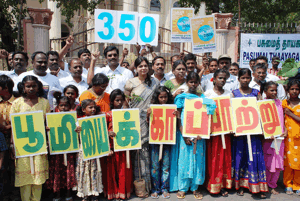
Citizens in Chennai, India host a rally for a strong climate treaty. (350.org)
VACHHARAJANI: Hi, my name is Bijal Vachharajani, and I work with 350 dot org, and I’m based out of Mumbai in India. Oh, there’s lots of stuff happening in India right now, for example, the Raj Bhavan, that’s the governor’s residence in Mumbai, they’ve pledged to go solar during this year at some point. We’ve got cycle rallies happening in Bombay, in Bangalore there’s going to be street plays by children.
In Hyderabad, there’s a whole group of college students who are going to clean up the lakes. Campuses across India are also gearing up for the Great Power Race. It’s a clean energy competition between students in China, India and the United States. So, the first round was to see which country can sign up the most teams. And right now, India is leading with 410 registrations. Since we’re already leading, let’s hope that we keep that lead up and that India does win.
An Interactive Map of Worldwide 10-10-10 events.
LEHMER: My name is Aaron Lehmer, and I’m in Oakland, California. We’re pulling together for ‘get down and dirty Oakland,’ which is going to be a big party in a garden at a school that needs revitalization. Plus, we’re going to be having a big party and concert, where we’re going to feature local hip-hop artists, we’re going to get the word out about some serious threats to climate protection here in California. The most prominent of which is Prop 23, which is an attempt to basically roll back our state’s clean air laws and global warming solutions.
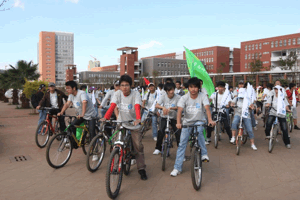
Students with the China Youth Climate Action Network who have worked with 350.org to connect climate groups at over 300 campuses across China. (350.org)
WELTON: My name is Carissa, I’m here in Beijing in the People’s Republic of China. We’re working on a series of events that are pretty focused on waste management, we’re hosting the ‘Great Green Race,’ which is a competition between teams to collect the most matter out of place, and create art with it. So it is a competition, we are awarding prizes for whoever can collect the most trash and help us with the sculptures. But the idea is really to bring people together. We’re trying to find ways where everyone can participate and collaborate- that’s the whole theme of this.
OLIVEIRA: My name is Evandro Oliveira, and I’m Portuguese, and I’m based in Berlin. In Europe we have lots and lots of actions. We have, for instance, in Barcelona, hundreds of people who are expected to take part in a bicycle powered music festival, and actually in Edinburgh, in Scotland, that is the city of the pubs, the locals will be driving a joycott, and a joycott is actually the reverse of a boycott. And, they will come together at the local bar, and the local bar agreed to put 20 percent of its revenues on ten-ten-ten to making the bar more energy efficient.

A giant 350 sign in Grenada, Spain made from solar ovens on their way to Africa. (350.org)
In Iceland, in Reykjavik, we have citizens that are starting to go on their bikes in their underwear to raise awareness on climate change. And, I mean, I have a list that never ends. It’s really from Russia to Iceland, from Portugal to Kosovo, and it really feels very good that we are adding to.
QINTANILLA: My name is Marcelo Qintanilla, I’m working in Mexico, and I’m coordinating activities for 350 Mexico. Well, we have big plans, now we have more than a hundred events registered in Mexico. Mexico has 32 states and we have at least an event in every state.

Hundreds of people form a giant sun in Mexico City as part of last October 24th's international day of climate action. This October 10, Mexico City is committing to reduce its CO2 emissions 10% over the next year. (350.org)
Mexico City is committing to reduce their emissions of CO2 ten percent for the next year, in 2011, and this will be achieved by a five percent commitment, making responsible the government, and the other five percent will be responsibility of Mexico City people. For Mexico City we have this event in Chapultepec, which is the biggest park in Mexico City. And, we’re having a big concert celebrating with the people- this commitment from Mexico City- and the concert will be powered by a solar bus- we have this bus that came in with solar panels and we’re going to power all the energy for having all these amazing concerts for over five hours.

A 350.org rally outside Kabul, Afghanistan organized by Sayed Massoud's organization, Afghan Youth for Sustainable Development and Tolerance. (350.org)
HASHIMI: I am Sayed Masood, from Afghan Youth for Social Development from Kabul Afghanistan. Our organization will gather a group of dedicated Afghan youth, joining the global world party that demands policy makers get to work too! We have decided that a number of 20-30 young Afghans will join us to plant a number of 20-30 trees in an effort to raise this awareness. You understand that Afghans are facing a huge number of problems in every sector of their lives. But we cannot ignore the other danger that we will face if not today, tomorrow, with the greatest impact on our lives- that is the climate change.
GELLERMAN: Afghanistan is just one of 175 countries planning climate action on ten-ten-ten. See an interactive map at our website L-O-E dot org.
[MUSIC: Bombay Dub Orchestra “Monsoon Malabar” from 3 Cities (Six Degrees records 2008).]
GELLERMAN: Coming up - a plan to restore the Gulf of Mexico and bridge the financial gulf to do it. Stay tuned to Living on Earth!
[MUSIC: Mark O’Connor: “Funky Swing” from Live In New York (OMAC Records 2010).]
Science Note: Sharks and Smell
GELLERMAN: It’s Living on Earth, I’m Bruce Gellerman. Just ahead – a new plan to make the Gulf of Mexico better than ever. But first, this Note on Emerging Science from Meghan Miner.
[SCIENCE NOTE THEME]
MINER: A state-of-the-art theater with surround sound gives the illusion that audio is just behind you, or to the right, or left. In the grand theater of the ocean, sharks experience surround-smell.
Scientists originally thought sharks used the intensity of smells to locate food. But, because smells don’t disperse evenly in water, marine biologists in Florida and Massachusetts wondered if this really was how sharks find their prey.
The researchers set up an experiment where sharks wore headgear that released scents of different concentrations- one nostril at a time. They found that even when an extremely diluted smell was sent to one nostril before a full strength odor was sent to the
other- the shark turned in the direction of the nostril that sniffed the smell first.
This showed that sharks use each of their two nostrils independently to pinpoint their food.
The finding may help explain why hammerhead sharks are considered the fastest and often the first sharks to reach prey. Hammerheads have nostrils on either side of their head, increasing the lag time between scents reaching each nostril- making them faster at honing in on dinner.
That’s this week’s Note on Emerging Science. I’m Meghan Miner.
Related links:
- Researcher Jayne Gardiner’s website
- Read the article in Current Biology
Spill Could Pick up Restoration Bill
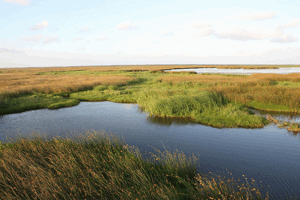
GELLERMAN: Now that the BP Deepwater Horizon oil well has been killed, how do we keep the Gulf of Mexico alive? That’s the fundamental question addressed in a just released report by Navy Secretary Ray Mabus. President Obama designated the former Mississippi governor to come up a plan for the long-term recovery of the Gulf coast after one of the worst environmental catastrophes in the nation’s history. Aaron Viles is the campaign director for the Gulf Restoration Network. The conservation group is based in New Orleans – and Mr. Viles, welcome to Living on Earth.
VILES: Thanks for having me.
GELLERMAN: In the introduction to his 126-page plan, Mr. Mabus says, and I quote, “America needs the Gulf. America needs the Gulf to be clean. America needs the Gulf to be healthy. America needs the Gulf to be sustainable.” And yet, you know, we’ve been insulting and injuring the Gulf for decades!
VILES: Right. Clearly, the BP drilling disaster is not the first time the oil industry has negatively affected the Gulf. It’s not the first time we’ve had a crisis, I think, worthy of the nation’s attention, but I think it’s certainly is, with this report, the first time that we’ve seen a very clear vision for national investment in the Gulf of Mexico, and in its restoration. And, that’s why we are, certainly, are pleased to see it released.
GELLERMAN: Well, lets talk about the report and what it suggests. What are the major findings?
VILES: What we like about the report is that it lays out some very clear principles: healthy coast wetlands and barrier shoreline habitats, fisheries that are healthy, fish populations that are healthy and sustainably managed, and more sustainable storm buffers out there for the Gulf. And then inland habitats as well, inland watersheds, which really do drive a lot of the ecological problems in the Gulf of Mexico, that those are healthy and well managed. So, I think they got their arms around all of it, as far as the principles, but I think for every plan, what’s really important is what comes out of it.
GELLERMAN: Well, action takes money. What I find ironic is that this disaster, and the money from this disaster could be the silver lining, or the gold lining.

VILES: Yeah, I think that is interesting- there’s an irony there. You know, the oil and gas industry has been treating the Gulf of Mexico as really a sacrifice zone, or a dumping zone for years, for decades. And now their biggest screw up ever could actually provide, really, the resources to jumpstart the restoration and recovery to deal with the legacy down here.
GELLERMAN: So, the funding for this will come from the fines that the BP oil company will have to pay then?
VILES: That’s what this report envisions. The cleanup money, that’s just BP has to spend it. They’ve got to clean it up, and they’ve got to just keep spending the money. But, this report envisions the Clean Water Act directing some of the fines and penalties to this recovery plan.
GELLERMAN: What are we talking about, bottom line figure?
VILES: What we do know, is that the fines and penalties for what BP has done in the Gulf, and you know, the historic barrels of oil that have been discharged, that could rack up as much as 20 billion dollars in fines and penalties if the department of Justice aggressively goes after BP for all of them. But, you know, clearly, that’s a lot of money. Wherever you come from, that’s a lot of money.
VILES: So, what’s the total cost then of restoring the entire coastline- do you have a guesstimate on that?
VILES: Well, it’s certainly a guesstimate, what we know is that in Louisiana alone, where our coastal marshes are disappearing, or they’re degraded, they’re falling apart really because of oil and gas and what we’ve done to the Mississippi River- that crisis alone can cost anywhere from 14 to 100 billion dollars to fix. You add in the other impacts that we’re talking about here- you know, clearly 100-200 billion dollars to really answer the call here to fix what’s broken with the Gulf and make it sustainable again.
GELLERMAN: So, now it’s up to Congress. They have to approve this plan and accept it?
VILES: Absolutely. We need Congress to act, and I think that’s one of the biggest challenges, because clearly Congress is wrapped up in lots of stuff. So as we watch, the kind of, oil disappear to a degree, although it’s not all gone there’s a lot out there in the water column, and we’re going to be dealing with it for years- if the media perception is that it’s gone, and the media moves on to the next disaster du jour, Congress is not going to have that same sense of urgency- because they’re not going to be hearing from, you know, outraged people.
And we know that, if you look at the history of Congress, they seem to respond best to outraged people. And that’s something that, you know, we’d like to see Congress act as soon as possible. And hopefully the administration will have some sway left and urge them to do this very thoughtful, very principled thing, which is direct these revenues down here to implement this plan.
GELLERMAN: You know, the Walton Family Foundation came up with a bipartisan poll, just recently, and they found that 75 percent of the people in the region, in the Gulf states, say the Feds should play a significant role in the restoration. I found that curious.
VILES: Well, I think the folks down here, as much as there’s an emphasis on local control and local guidance, they understand that with a resource as big as the Gulf- and you know, we’ve got all five Gulf states engaged in it- and when a crisis like the BP disaster happens- you’ve gotta have a big entity step in and take action. And I think that’s what you’re seeing with this poll, is that the public knows it’s a big problem and we’ve gotta get the government engaged here to really commit and see through the plan.
GELLERMAN: You’ve seen disasters come and go, you’ve seen plans come and go. Are you getting a little tired of this?
VILES: There’s certainly a disaster fatigue. And as I sat here last night going through this plan, there’s certainly the cynical side of me that says, ‘oh, I feel like I’ve seen some of this language before.’ And, you know, the last five years have been rough for the Gulf of Mexico. And, we’ve seen a lot of federal and state collaborative agencies and efforts put together plans. And, we’ve got a lot of paper gathering dust right now. So that, I think, is ultimately- that’s arbiter of whether this is a useful endeavor, is whether we get action. And so that’s what we’re going to be very focused on.
GELLERMAN: Aaron Viles is campaign director for the Gulf Restoration Network. Mr. Viles, thanks a lot.
VILES: Thank you.
Related links:
- Read Navy Secretary Ray Mabus' recommendations here
- Click here for more on the Gulf Restoration Network
[MUSIC: The Faces “Sweet Lady Mary” from The Best Of The Faces: Good Boys When They’re Asleep (Rhino Records 2005).]
Human Waste in the Wild
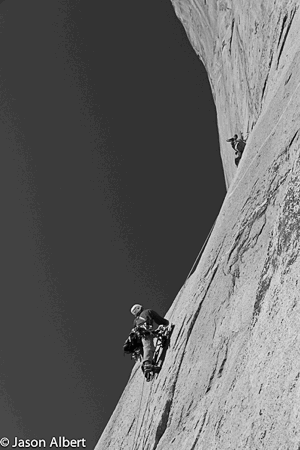
GELLERMAN: No motors, no buildings, no trace of human endeavor. Wild. That's what designated wilderness in the United States is supposed to be. But millions of people visit wilderness sites each year, and when they gotta go they sometimes leave their waste behind. Jason Albert reports from California’s Yosemite Valley.
[SOUNDS FROM ON THE MOUNTAIN]
ALBERT: Jesse McGahey, dressed in a white haz-mat suit, hangs by a thread and looks down 3,000 feet. He’s just been lowered over the cliff edge of El Capitan, Yosemite’s iconic rock face.
[SOUND OF CLIMBING, RUNNING WITH ROPES TO LIFT EQUIPMENT]
ALBERT: McGahey, 32, is Yosemite Park Climbing manager. He’s about to descend into Camp Six, a high altitude rock campsite wedged like a flat table into an open book.
McGAHEY: Approaching Camp Six. There it is. Nicest bivy on The Nose. Yet, full of s***. We are going to try to change that right now.
ALBERT: This vertical climbing route is called the Nose, and McGahey is calling this mission the Nose Wipe. He and a partner are here to retrieve decade’s worth of refuse left by climbers. They fill two bags with over one hundred pounds of garbage, climbing gear, even solid human waste.
[HELICOPTER]
Albert: A waiting helicopter sling-loads the cargo away. And gets a warning about the contents.
[RADIO SOUNDS: McGAHEY: …It’s got some bio hazard in it, so folks should be careful handling it. PILOT: Roger that]
ALBERT: Far down below in El Capitan Meadow, Ken Yager recounts how it came to this. He first climbed The Nose more than 30 years ago. Now he organizes the Yosemite ‘facelift’ an annual park clean up.
YAGER: Back then, it was very rare to even have another party on El Capitan so you didn’t have the problems that you run into nowadays.
ALBERT: Climbing routes are vertical trails. Deviating from the path is risky. Yet the climbers in the 1970s managed to relieve themselves using an area of the wall away from the main climbing route.
YAGER: Ah 1980’s- that’s when a lot more people started going up on El Capitan and so you’d poop in a paper bag, and then they’d try to toss ’em as far off the cliff as they can. And the idea being that you’d drop to the base and pick these up after the climb.
ALBERT: As climbing use on El Capitan increased, so did waste at the wall’s base. Picking up other climbers’ food garbage was one thing; handling anonymous biological waste was another.
YAGER: It became pretty ugly for awhile.
ALBERT: The Park Service mandated climbers pack out their waste. And Yosemite climbing manager Jesse McGahey says the great majority do.
McGAHEY: There is a strong ethic from the climbing community, and they’re more self-policing than I am. They started packing out their human waste before we mandated it.
ALBERT: It’s just that in a rock environment like Camp 6, every individual can have a major impact.
McGAHEY: You couldn’t pick a more beautiful spot to spend an evening on El Cap. And unfortunately, out of the whole park for a campsite, that is the closest thing we have to a garbage dump in wilderness.
ALBERT: Part of it is, inexperienced groups come here and get exhausted. Also, no permit is required to climb on El Capitan. So rangers don’t really know who’s spending the night on the rock.
[FOOTSTEPS]
ALBERT: So it’s the daily work of Yosemite rangers like Eric Bissel to find climbers in technical terrain and get the word out.
[CLIMBING NOISES]
BISSEL: We’re just going to head up today to check out for trash. And there’s a couple of parties on the route so we’ll talk to them as we’re going and make sure that they have proper waste management equipment with them.
ALBERT: A stark contrast lies about 200 miles south - Mount Whitney, the tallest mountain in the lower 48. Diana Pietrasanta is now a deputy district ranger on the Inyo National Forest. She began as a Mt. Whitney ranger. Back then, one of her responsibilities was maintaining the two solar toilets on the flanks of the mountain.
PIETRASANTA: I sort of went into the job with my eyes wide open knowing that there were these two toilets along the Whitney trail and it would be my responsibility to take care of them, or maintain them. But I didn’t realize that it was probably the major component of the job at the time. Out of a week, I would probably spend probably half my time dealing directly with the toilets.
ALBERT: Mt. Whitney managers used a progression of toilet designs - all with the same result. Rangers became de-facto backcountry sanitation workers. And the human footprint proved massive. A helicopter spent three days every summer season ferrying loads out of the Wilderness.
PIETRASANTA: Its kind of like if you have a campfire, you don’t have a campfire- people will cluster around the campfire. And the toilets were the campfire of the Whitney Trail. So both from a visual and sensory aspect, you know, it is not what you would normally consider a wilderness experience.
ALBERT: So in 2004, at the base of the mountaineer’s route to Whitney’s summit, the Forest Service set out a dispenser for free Wag Bags, specially designed bags for when you have to go. And people used them. Three years ago Whitney managers were able to take out the last toilets and mandate a pack-it-out policy for the zone’s 23,000 climbers and hikers.
[RANGER INFO TALK:KIRK: Okay. Have you done the Whitney Trail before?
HIKER: Yes Sir.
KIRK: Day Hike?
HIKER: Yes.]
ALBERT: Unlike at Yosemite, every climber here at Mt Whitney has to get a permit, and to get a permit, they have to have a face to face meeting with a wilderness ranger, like Dave Kirk.
KIRK: Don’t leave anything in the wilderness, don’t leave any litter, clothing, stuff like that. There’s the tags. Ah this is the permit. That’s an important document so just keep that with you…
And then human waste disposal so…wag bags. And yeah do help us out with this, um you know last year hikers individually packed out six thousand five hundred pounds off the mountain that would otherwise be under rocks up there. So just let everyone know they’re really doing their part to protect the wilderness when they use this.
[SOUND OF WIND AND CREEK]
ALBERT: Veteran witnesses at Mt. Whitney say it has to be this way. Doug Thompson runs the Whitney Portal store, at 8,000 feet elevation, it’s been a climber’s last chance for supplies since 1935.
THOMPSON: This is the best balance. It just seems to me the best overall solution. You can’t have the rangers handle it, you can’t expect somebody else to carry out your waste. So this puts the responsibility back on the individual. And you always have that choice, of…there’s a lot of places you don’t need a wag bag.
[CLIMBING GEAR SOUND]
ALBERT: And for climbers the risks of improper disposal of human waste continues to be real. Ivan Valenta, a climber from Sydney, Australia and his wife attempted to climb The Nose.
VALENTA: She actually picked up a wall-bug because people do their business on the ledges and stuff like that. I spent the next two days holding a garbage bag under her backside till we could get off. Memorable moment for me.
ALBERT: Yet even Valenta’s closeup with dysentery didn’t cloud his enthusiasm for Yosemite climbing.
VALENTA: You don’t want it to be stopped and we’re not allowed to use it anymore because we’re trashing it. So, you know, look after what you’ve got and you’ll be able to come back many times to enjoy it.
ALBERT: So next time you head out into the remote beyond, don’t be afraid when you find a wag bag dispenser at the trailhead.
[SOUND OF CLIMBER CROSSTALK: Can I come up? No, just a minute…]
ALBERT: For Living On Earth, I’m Jason Albert in Yosemite Valley, California.
GELLERMAN: For a slide show of packing it up at Yosemite head over to our website – L-O-E dot org.
Related links:
- Watch a movie about recovering human waste in Yosemite
- Leave No Trace is a group promoting a ‘leave no trace’ ethic.
- A conference about human waste management in the backcountry
- Ken Yager organizes the Yosemite Facelift.
[MUSIC: Hot Tuna “ Mann’s Fate” from Hot Tuna (BMG Records 1996).]
BirdNote® - Ravens and Crows

A Common Raven (Photo: Tom Grey ©)
[CALLING RAVEN]
[BIRDNOTE THEME]
GELLERMAN: Crows and ravens are birds of a feather. They’re the same genus – Corvus – and to borrow a punchline from comedian Rodney Dangerfield, ‘both don’t get no respect.’ But there are differences between crows and ravens, and in this BirdNote ®, Michael Stein tells us how to tell them apart.
[FOREST SOUNDS AND CALL OF THE COMMON RAVEN]
STEIN: You’re outside, enjoying a sunny day when a shadow at your feet causes you to look up. A large, black bird flies over and lands in a nearby tree. You wonder: is that a crow or a raven?
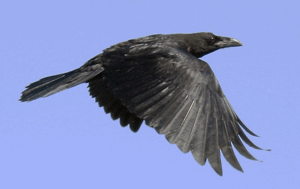
A Common Raven in flight. (Photo: Tom Grey ©)
[CALL OF THE RAVEN]
STEIN: These two species, Common Ravens and American Crows, overlap widely throughout North America, and they look quite similar. But with a bit of practice, you can tell them apart.
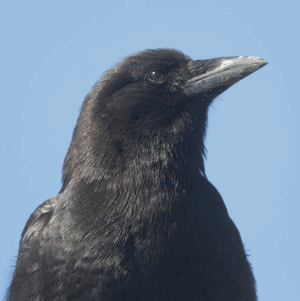
An American Crow (Photo: Tom Grey ©)
You probably know that ravens are larger, the size of a Red-tailed Hawk. Ravens often travel in pairs, while crows are seen in larger groups. Also, watch the bird’s tail as it flies overhead. The crow’s tail feathers are basically the same length, so when the bird spreads its tail, it opens like a fan. Ravens, however, have longer middle feathers in their tails, so their tail appears wedge-shaped when open.

A Common Raven (Photo: Tom Grey ©)
Listen closely to the birds’ calls. Crows give a cawing sound. [Crow’s caw, caw] But ravens produce a lower croaking sound. [Raven’s croak]
GELLERMAN: Quoth the raven……now you know. Our BirdNote ® was narrated by Michael Stein. For photos and more info, flock to our website- L-O-E dot org.
Related links:
- Crow and Raven calls provided by The Macaulay Library of Natural Sounds at the Cornell Lab of Ornithology, Ithaca, New York.
- Crow and Raven calls provided by The Macaulay Library of Natural Sounds at the Cornell Lab of Ornithology, Ithaca, New York. American Raven recorded by R.S. Little, American Crow recorded by G. A. Keller.
[MUSIC: Gary Burton & Keith Jarret “The Raven Speaks” from Throb (Atlantic Records 1970).]
GELLERMAN: Just ahead, the deadly history and lethal legacy of a vital Cold War element – uranium. Keep listening to Living on Earth!
[MUSIC: Greyboy With Karl Denson: “Grey’s Groove” from the Best Of Cookin (Ubiquity Records 2000).]
Yellow Dirt
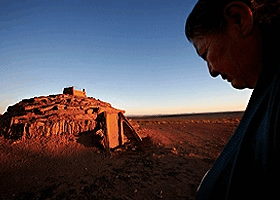
Pasternak's powerful four-part series for the Los Angeles Times won numerous awards. (Photo: Gail Fisher, LA Times)
GELLERMAN: It’s Living on Earth. I’m Bruce Gellerman. Judy Pasternak, a former investigative reporter with the Los Angeles Times, has written an epic story about US efforts to obtain uranium during the cold war. Her book, Yellow Dirt, chronicles how mining companies walked away, leaving radioactive ore and tailings behind. And 60 years later Americans in the southwest were still being exposed. Judy Pasternak spoke with Living on Earth’s Steve Curwood.
CURWOOD: You begin your story in Indian country in Arizona in the 1920s, 30s and 40s, and you found that some Navajo suspected that they might have some special rocks that outsiders coveted. What had they noticed?
PASTERNAK: They noticed these yellow stripes in the rock, powder-yellow stripes. And, really, the first people who settled this one valley that’s the central setting for my book- thought that this was gold.
CURWOOD: So, this is an area that white people call “Cane Valley,” where people noticed, the Navajo noticed these rocks. And, one of your main characters in this story of ‘yellow dirt’ tells his children, ‘Never ever tell any of the white men about these rocks.’ But, I guess, temptation eventually overtakes one of them.

Judy Pasternak's new book on uranium poisoning in Navajo country is just out.
PASTERNAK: Yeah, (laughs), his son, in fact, his favorite son. And, that was well before atomic bombs were being developed. But, later, during WWII, one of the Indian traders put some rocks, some samples, out on his counter, and he told the son, who was a customer, that this could be worth a lot of money.
CURWOOD: And, the son immediately goes out and…
PASTERNAK: Yeah…so…yes. So then he gathered up some of these rocks that were on the mason, and then brought them in.
CURWOOD: And it turns out this isn’t just any old uranium deposit, Judy, but this is the mother load of powerful uranium. Very rich uranium. What, hundreds of mines are blasted and tunneled across the land as a consequence as this.
PASTERNAK: Yeah, the Navajo reservation as a whole, really has world-class deposits of uranium. And, the mesa that rose above Cane Valley was the hottest, richest, most productive uranium mine on Navajo land.
CURWOOD: We know a fair amount about the miners- the health effects on them- but your book also documents, I think, for the first time…I’ve read this…maybe it’s in other material, about the broad range of suffering that the whole Navajo community suffered as a function of exposure. Tell us about the watering holes that were left from the surface mining, for example.
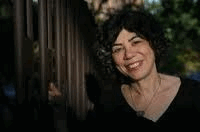
Author, Judy Pasternak.
PASTERNAK: There were huge open-pit uranium mines in the western part of the reservation because the deposit was so shallow- they could just blast it right out of the ground. When the mining companies left, according to their contract, they were supposed to return the land in as good condition as received. But nobody asked them to fill in these pits.
And, what happened was- they collected rain. And, these pits, some of them were half a mile long. They looked like lakes in the desert, they looked like oasis. So, shepherds who were coming by were actually pretty grateful for their presence because all of a sudden here was a water supply in the desert. And, so, they would drink. They would water their herds there and they would drink themselves.
CURWOOD: And, in Navajo culture, the shepherds are often women.
PASTERNAK: That’s right, and some of those women were pregnant.
CURWOOD: What happened to them?
PASTERNAK: There is a correlation between women who drank contaminated water while they were pregnant and a syndrome that’s known as ‘Navajo Neurapathy’. Children who have this, generally the average age of death is ten. Some lived into their thirties. They had fused, stiffened, fingers and toes that were kind of like claws. Many of them had liver damage- also they had problems with the nerves in their corneas, so often it was hard for them to see.
CURWOOD: The average age of death was ten?
PASTERNAK: That’s right.
CURWOOD: And then, abruptly, in the late 1960’s the Cold War is over, the government has enough uranium, thank you. Basically the mines close up and this is so damning, the government, which is the legal guardian of the tribe, just allows these mining companies to walk away.
PASTERNAK: Yeah, that’s correct. And, the mines themselves, the portals were left open. Anybody could wander in. There were great piles of waste rock around and there were these large hills or small mountains of sandy waste, radioactive waste.
CURWOOD: I imagine kids played in this stuff then?
PASTERNAK: That’s correct. And they predicted that kids might play on them, and indeed they did. They used to dig caves in them in the summertime. And, in the wintertime, they were a wonderful attraction, you know, it was the only place around to go sledding.
The way Navajo’s lived their lives gave them a much greater exposure than people in a town or city would have. They also used the ore, because they were very practical and also very poor. They used the ore, which had been nicely squared off by the blasting to build foundations for their houses, and fireplaces and bread ovens. They used these sandy leftovers from the four processing mills that were on the reservation to mix cement, and it got a reputation for making really nice, smooth cement. So they used it for floors that they slept directly on, and stucco walls. So, they brought this stuff into their daily lives, into their homes.

Pasternak's powerful four-part series for the Los Angeles Times won numerous awards.
(Photo: Gail Fisher, LA Times)
CURWOOD: So, Navajo are making homes out of uranium and other related, other radioactive materials.
PASTERNAK: Yeah. In essence, they were living in another mine.
CURWOOD: Meanwhile, of course, the largely white uranium towns in Colorado, like Grand Junction, are getting cleaned up.
PASTERNAK: Right. And, a lot of that was a matter of having political clout. Grand Junction had a processing mill in town, and when it was realized that people had been coming in and taking some of the sand to use in construction, the federal government spent 250 million dollars taking the contaminated stuff out of the homes of thousands there. They went house to house, where they dug up contaminated soil, they would replace the trees and the grass. But, at the same time, Navajo’s were actually using the material to put it into their homes.
CURWOOD: Your series of articles runs in the Los Angeles Times, what in 2006, and some wheels began to turn after that. Tell us what happened.
PASTERNAK: One thing that happened, was that Congressman Henry Waxman read the series and he thought that, actually, other members of Congress who had Navajo constituents, might do something, but nothing much happened. And part of that is that there isn’t anybody who really represents the whole reservation. And so, Waxman decided after awhile that he was going to do something about it because he found it embarrassing- the situation.
CURWOOD: Now, if this time Congressman Waxman, who is a Democrat from California, is what, chairing the house oversight committee?
PASTERNAK: Well, yeah, with the oversight committee. And so, he basically, his jurisdiction was, as he put it, everything. They had a hearing, for the first time they brought a number of federal agencies to account together. It was hard to point fingers when the others were there. But, he did something that was also pretty unusual.
He also followed up after the hearing- he has since continued to bring these people together for meetings, including the Navajo tribe there, and the various agencies. And he has pushed them to come up with a five-year, multi-agency cleanup plan, which probably won’t do the whole job, but getting some momentum going- it’s now in year two.
CURWOOD: I believe you say in your book that Navajo official, he had what, a Geiger counter at this congressional hearing?
PASTERNAK: Yeah, he brought the soil in. And they had had to inform the capital police ahead of time, and he ran a Geiger counter over this container of material, and the noise of the clicks just filled the room. The police immediately took it and got it out of there- ‘time to go!’ (Laughs).
CURWOOD: Time to go. And so, after Congressman Waxman’s hearings, and your story- I gather slowly, some of these radioactive homes, what is now a fourth generation of Navajo’s sleeping in them- they’re getting cleaned up?
PASTERNAK: Yeah. I had the pleasure last fall of tagging along with someone from the US EPA and the Navajo EPA as they were giving out keys to new, safe homes, to people whose contaminated houses had been knocked down. And, they were pretty shocked people to find that something was actually happening, after all this time. It was bittersweet though, because people had died, in the meantime.
CURWOOD: Judy, thanks so much for taking the time with me today.
PASTERNAK: Thank you very much for having me on the show.
GELLERMAN: Living on Earth’s Steve Curwood and author Judy Pasternak. Her new book is “Yellow Dirt, an American story of a Poisoned Land and a People Betrayed”.
Related links:
- Read Judy Pasternak’s four part series, “A peril that dwelt among the Navajos”
- View a slideshow produced for the Los Angeles Times series
[MUSIC: Undersea Poem “Bacocho Sunsets” from Undersea Poem (Six Degrees Records 2010).]
The Power is (Still) Yours

The Planteer posse use their power rings to fight pollution. (Photo: Captain Planet Foundation, © 2009 TBS Productions, Inc.)
GELLERMAN: A team of five young people, from five continents, were given five magic rings. “With their powers combined” these kids summoned Earth’s greatest champion: Captain Planet. The eco-cartoon hero and his team of Planeteers first took to the airwaves 20 years ago, inspiring a generation of TV viewers to do no less than save the planet. Living on Earth and Planet Harmony’s, Ike Sriskandarajah watched back then - and has our story now.
SRISKANDARAJAH: In 1990, NBC News Today announced a new superhero:
TV: Teachers and parents often look at Saturday morning television as a kid’s wasteland full of cartoon garbage and sugar cereal ads. Well, tomorrow there’ll be a new TV character trying to change that.
SRISKANDARAJAH: And his name was Captain Planet…
TV: I am Captain Planet …Go Planet!!
SRISKANDARAJAH: Captain Planet was the brainchild of Ted Turner. The ecological warnings of the Global 2000 report, commissioned by President Carter, spurred Turner to beef up Turner Broadcasting’s environmental programming.
TURNER: Most of the experts say that if we don’t change things, the planet will be pretty well uninhabitable in another 30 or 40 years.
The pilot episode lays out the "creation story" for this new superhero.
SRISKANDARAJAH: Turner hired TV producer Barbara Pyle to sound the alarm.
PYLE: he wanted me to teach children about the facts of the Global 2000 study! I mean go figure. Ted Turner called me into his office and he said, “Captain Planet” and I said Ted, what is Captain Planet? And he said, that is your problem.
[SHOW: I AM CAPTAIN PLANET!]
[CAPTAIN PLANET THEME SONG: Captain Planet, he’s a hero- gonna take pollution down to zero!]
SRISKANDARAJAH: So Barbara and her team dreamt up an elemental warrior, in league five kids with magic rings
PYLE: If you think of Captain Planet as a religion (laughs), then this would be the creation myth- the creation story.
SRISKANDARAJAH: The pilot episode lays out the themes. It begins with eco-villain, oil-hungry, Hoggish Greedly, voiced by Ed Asner.
[SHOW: HOGGISH GREEDLY: With this giant land blaster I’ll be able to drill for oil anywhere.]
BARBARA: Well, basically they crack the ocean floor. So, anyway, Gaia is taking a nap and she is woken up by oil dripping onto her forehead.
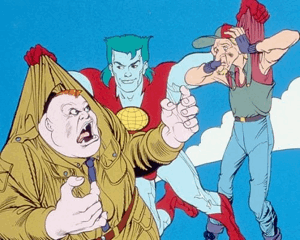
Captain Planet takes out the villainous trash. (Photo: Captain Planet Foundation, © 2009 TBS Productions, Inc.)
SRISKANDARAJAH: Gaia is the spirit of the earth, trying to sleep in her subterranean palace.
[SHOW: GAIA: My goodness, can’t the spirit of Earth take a little nap.]
PYLE: ‘Get a little nap,’ she said. And then she flicks on her monitors, boom! And there they are, she’s seeing all the travesties happening on the planet today.
[SHOW: GAIA: I guess I napped to long… but how much damage could they do in a century…]
PYLE: The exhaust from the cars, the pollution in the river, everything you name it, the best b-roll of environmental disaster.
[SHOW: GAIA: It’s worse than I thought, Earth is dying…]
PYLE: Only it’s animated, of course. And then she says its time for the rings. She tosses out the rings.
[SHOW: GAIA: I need young people to help now. Starting with five very special kids from five corners of the globe.]
SRISKANDARAJAH: Each ring held the power to control one natural element
[SHOW: GAIA: From Africa, Kwame.]
SRISKANDARAJAH: Kwame could move earth.
[SHOW: GAIA: From Asia, Ghee.]
SRISKANDARAJAH: Ghee could control water.
[SHOW: GAIA: From North America, Wheeler.]
SRISKANDARAJAH: Wheeler shoots fire.
[SHOW: GAIA: From the Soviet Union, Linka.]
SRISKANDARAJAH: Linka harnessed the wind.
[SHOW: GAIA: And, from South America, Ma-Ti.]
SRISKANDARAJAH: Ma-Ti has the power of heart.
[SHOW: Alright, now let me get this straight. Your name is Gaia and you are the spirit of the earth? And you brought us here to help you save earth from being ruined? Yes, that’s about the size of it.]

The Planeteer posse use their power rings to fight pollution. (Photo: Captain Planet Foundation, © 2009 TBS Productions, Inc.)
SRISKANDARAJAH: Gaia tells the kids, the Planeteers, they must work together to do that.
[SHOW: We must do as Gaia advised, we must combine our powers. Let’s do it!]
SRISKANDARAJAH: So the newly formed team takes Gaia’s advice to clean up Greedly’s Oil spill.
PYLE: Boom! There’s captain Planet.
[SHOW: By your powers combined, I am Captain Planet….Go Planet!]
PYLE: What Captain Planet truly is- he’s a metaphor for teamwork. He doesn’t exist without the Planeteers.
[SHOW: CAPTAIN PLANET: Now the first order of business is to put all this oil back where it came from….]
PYLE: And he does the heavy work. And he caps it. And then he says goodbye to the Planeteers.
[SHOW: CAPTAIN PLANET: My works here is done but yours is just beginning Planeteers... and remember, the power is yours.]
SRISKANDARAJAH: For 6 seasons, that was the slogan- that kids have the power to change the world.
GOLDBERG: this is one of the few things that talks to kids about what they can do.
SRISKANDARAJAH: That’s Whoopi Goldberg, the voice of Gaia.
GOLDBERG: We won’t know what the outcome of this is until these kids grow up.
SRISKANDARAJAH: Now that generation, the millenials, have graduated from Saturday morning cartoons and college…Barbara Pyle:
PYLE: That’s actually, that group of young people is the largest demographic bulge in the history of our species on this planet and they are aging into their power years.
SRISKANDARAJAH: She says about half of the 80 million millenials in the US saw the show, as well as fans in nearly 100 other countries. Now there’s an international network of Planeteers who care about the environment.
ALEJANDRA: (Speaking in Spanish about her love for the show).
SHONA: Hi, my name is Shona and I’m from the North of Scotland, Inverness. I think Capain Planet was ahead of this time. I think now the time is ready to pay a little more energy to conservation.
SRISKANDARAJAH: The global problems Captain Planet fought- pollution, waste and oil spills- are still with us. And so is Captain Planet. He lives forever, in reruns. For Living on Earth and Planet Harmony, I’m Ike Sriskandarajah.
[CAPTAIN PLANET THEME SONG]
GELLERMAN: For more on the international network of Planeteers visit My Planet Harmony dot com. Our sister program, Planet Harmony, welcomes all and pays special attention to stories affecting communities of color. Log on and join the discussion at My Planet Harmony dot com- it’s the thing to do!
Related links:
- The international network of Planeteers has galvanized around the 20th anniversary
- Watch several classic episodes of the show on the Mother Nature Network
GELLERMAN: On the next Living on Earth, coal companies threaten to blow up a piece of mining history.
RULE: It’s worse than burying it, it’s just completely obliterating, doing away with it altogether. They don’t want you to know how terrible the coal companies treated the families who lived in this area. And that’s what we’re looking at here.
GELLERMAN: The battle to save the battlefield on Blair Mountain, next time on Living on Earth.
[Douglas Quin “Canada Glacier” from Antartica (Wild Sanctuary.com 2002).]
[CRACKING ICE, MELTING ICE]
GELLERMAN: We leave you this week at the South Pole. Canada Glacier is small as glaciers go, and despite the fact that it’s made of ice, it’s technically a desert. It’s so dry it only gets about 4 inches of snow a year. Douglas Quin recorded the sound of cracking ice on Canada Glacier for the Wild Sanctuary dot com CD “Antarctica.”
[GLACIER SOUNDS]
GELLERMAN: Living on Earth is produced by the World Media Foundation. Our crew includes Bobby Bascomb, Eileen Bolinsky, Ingrid Lobet, Helen Palmer, Jessica Ilyse Smith, Ike Sriskandarajah, Mitra Taj, and Jeff Young, with help from Sarah Calkins, and Sammy Sousa. Our interns are Nora Doyle-Burr and Honah Liles.
Jeff Turton is our Technical Director. Alison Lirish Dean composed our themes. Steve Curwood is our Executive Producer.
You can find us anytime at L-O-E dot org, and check out our Facebook page – it’s PRI’s Living on Earth. I’m Bruce Gellerman, thanks for listening.
ANNOUNCER: Funding for Living On Earth comes from the National Science Foundation supporting coverage of emerging science. And Stonyfield farm, organic yogurt and smoothies. Stonyfield pays its farmers not to use artificial growth hormones on their cows. Details at Stonyfield dot com. Support also comes from you, our listeners. The Ford Foundation, The Town Creek Foundation, The Oak Foundation—supporting coverage of climate change and marine issues. And Pax World Mutual Funds, integrating environmental, social, and governance factors into investment analysis and decision making. On the web at Pax world dot com. Pax World for tomorrow.
ANNOUNCER 2: PRI – Public Radio International
Living on Earth wants to hear from you!
Living on Earth
62 Calef Highway, Suite 212
Lee, NH 03861
Telephone: 617-287-4121
E-mail: comments@loe.org
Newsletter [Click here]
Donate to Living on Earth!
Living on Earth is an independent media program and relies entirely on contributions from listeners and institutions supporting public service. Please donate now to preserve an independent environmental voice.
NewsletterLiving on Earth offers a weekly delivery of the show's rundown to your mailbox. Sign up for our newsletter today!
 Sailors For The Sea: Be the change you want to sea.
Sailors For The Sea: Be the change you want to sea.
 The Grantham Foundation for the Protection of the Environment: Committed to protecting and improving the health of the global environment.
The Grantham Foundation for the Protection of the Environment: Committed to protecting and improving the health of the global environment.
 Contribute to Living on Earth and receive, as our gift to you, an archival print of one of Mark Seth Lender's extraordinary wildlife photographs. Follow the link to see Mark's current collection of photographs.
Contribute to Living on Earth and receive, as our gift to you, an archival print of one of Mark Seth Lender's extraordinary wildlife photographs. Follow the link to see Mark's current collection of photographs.
 Buy a signed copy of Mark Seth Lender's book Smeagull the Seagull & support Living on Earth
Buy a signed copy of Mark Seth Lender's book Smeagull the Seagull & support Living on Earth

